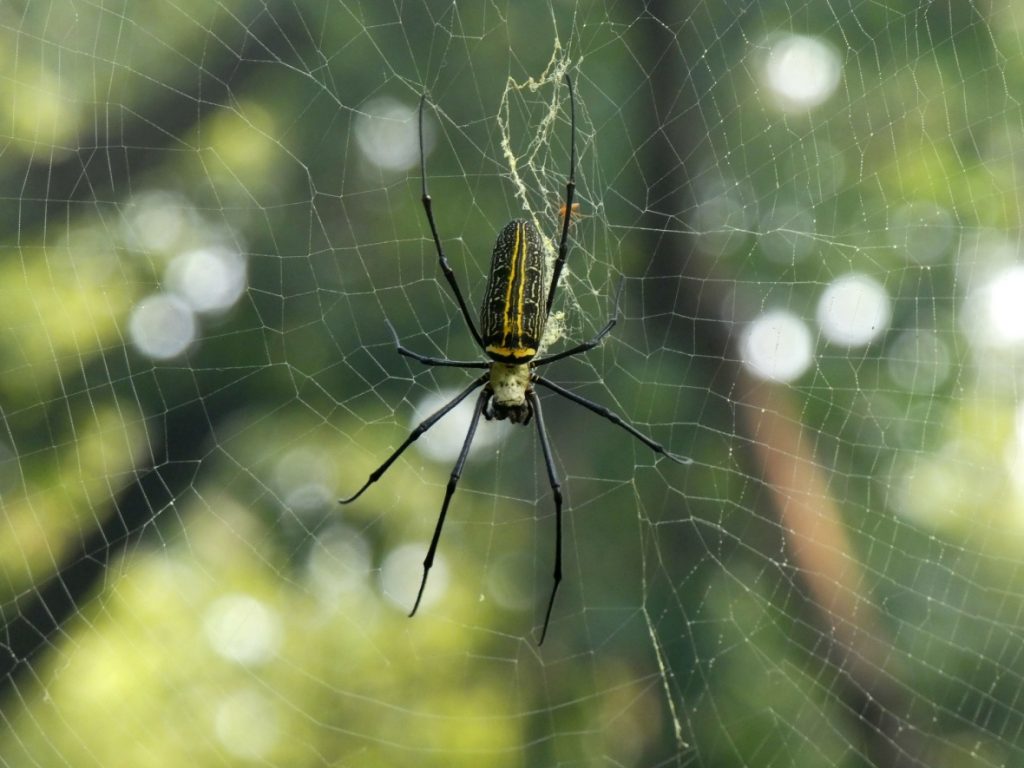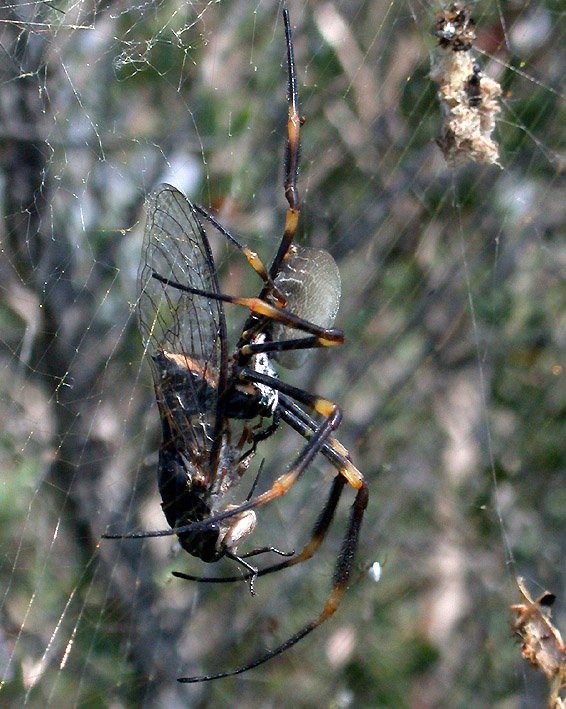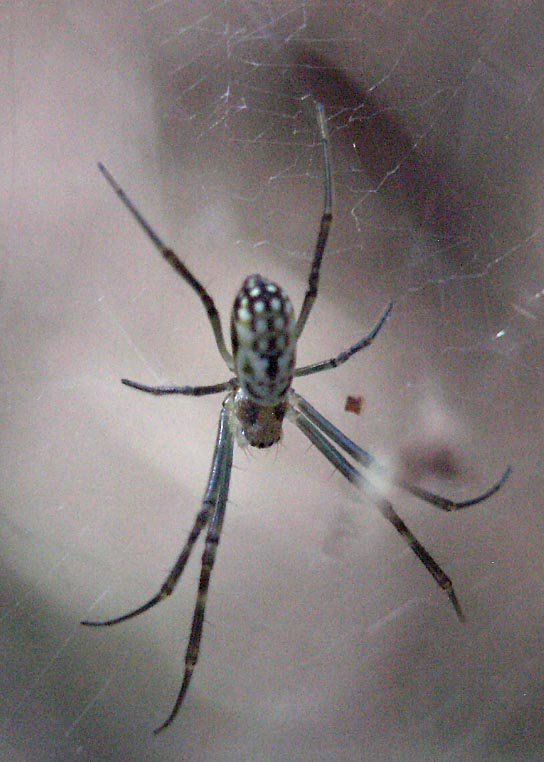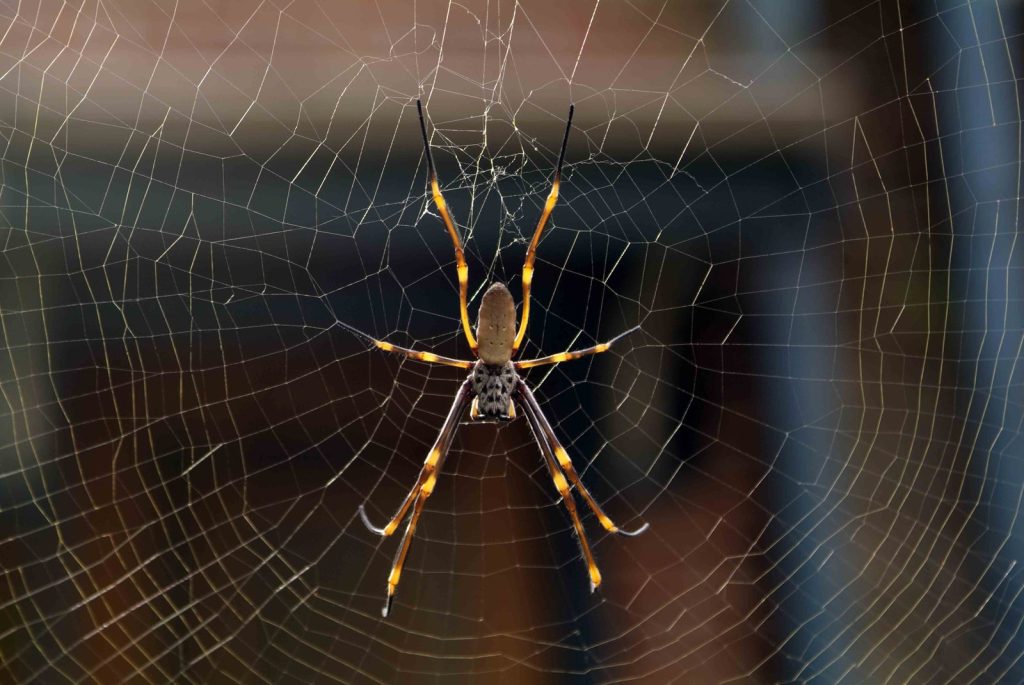Golden Orb Weaving Spiders:The Golden Orb Weaving Spiders build large, strong orb webs with a golden sheen.
Identification
Golden Orb Weaving Spiders are large spiders with silvery-grey to plum coloured bodies and brown-black, often yellow banded legs. The males are tiny and red-brown to brown in colour. The main difference between the common Sydney species, Nephila plumipes and N. edulis (which is commoner in inland regions) is the presence of a ‘knob’ on the front of the sternum (the heart shaped plate on the underside of the body between the legs) of N. plumipes.

Habitat
Golden Orb Weaving Spiders are found in dry open forest and woodlands, coastal sand dune shrubland and mangrove habitats.
All orb weaving spiders make suspended, sticky, wheel-shaped orb webs. Webs are placed in openings between trees and shrubs where insects are likely to fly.
Distribution
Golden Orb Weaving Spiders are found in dry open forest and woodlands, coastal sand dune shrubland and mangrove habitats, with Nephila edulis and N. plumipes being the two species found in the Sydney region.
In Sydney, the bushes and trees of the Royal Botanic Gardens are a good place to see them, as are the mangrove forests of Bicentennial Park and the Homebush Bay area of the city.

Feeding and diet
Golden orb weaving spiders prey items include flies, beetles, locusts, wood moths and cicadas. Sometimes their strong webs manage to trap small birds or bats, and the spider will wrap them and feed upon them.
Other behaviours and adaptations
The Golden Orb Weaving Spiders build large, semi-permanent orb webs. The strong silk has a golden sheen. These spiders remain in their webs day and night and gain some protection from bird attack by the presence of a ‘barrier network’ of threads on one or both sides of the orb web.
Like the St Andrew’s Cross Spider, they will vibrate their webs to distract potential predators. Sometimes aggregations of Golden Orb Weavers are found, with a tangled network of overlapping webs. Their webs are often host to the small kleptoparasitic spiders of the genus Argyrodes (often the Quicksilver Spider, Argyrodes antipodeanus) which inhabit the larger spider’s web and eat the smaller insects that become trapped on the web, thereby helping keep the web clear of debris.

Life history cycle
In the Golden Orb Weaving Spider group, it is common for a number of tiny (6 mm) males to live around the edges of a female’s web, waiting for a mating opportunity. After mating, the female Golden Orb Weaving Spider wraps her single egg sac in a mass of golden silk, which is then hidden on foliage away from the web, disguised within a curled leaf or sprig of twigs.
Predators
Predators of orb weavers include several bird species and wasps of the family Sphecidae. The wasps land on the web, lure the spider to the perimeter by imitating a struggling insect’s vibrations, and then carry the spider away to be paralysed and stored as live food for their young.

Danger to humans
Orb weavers are reluctant to bite. Symptoms are usually negligible or mild local pain, numbness and swelling. Occasionally nausea and dizziness can occur after a bite.
Seek medical attention if symptoms persist.
How to Identify a Golden Orb Weaver Spider: A Comprehensive Guide
Identifying a golden orb weaver spider, known for its striking appearance and distinctive webs, is a fascinating aspect of exploring nature. These spiders, also referred to as orb-web spiders or giant orb spiders, command attention with their size and the intricate designs of their silk constructions. The golden orb weaver spider plays a crucial role in ecosystems, contributing to the balance by regulating insect populations.
This comprehensive guide will delve into the physical characteristics that set the golden orb weaver apart, including its species variability, and explore the strength and construction of its remarkable webs. Additionally, it will cover the spider’s habitat and distribution, diet and prey capture methods, reproductive behaviors, and interactions with humans and other species. Armed with this information, readers will gain a thorough understanding of these captivating creatures and their presence in the natural world.
Physical Description and Species Variability
- Classification and Size
- The Golden Orb Weaver Spider is classified under the Genus Nephila, Family Nephilidae, showcasing a significant size dimorphism between genders. Females range from 2 cm to 4 cm in body length, whereas males are much smaller, approximately 5 mm.
- Physical Characteristics
- These spiders exhibit a distinctive physical appearance:
- Body: Long, rounded, and olive brown with light spots.
- Legs: Very long, contributing to their noticeable size.
- Color Variation: Ranges from red to greenish yellow, adorned with bright white patches on their head and body, and striped legs.
- Identification Feature: A notable difference between the common Sydney species, Nephila plumipes and N. edulis, is a ‘knob’ on the sternum of N. plumipes.
- These spiders exhibit a distinctive physical appearance:
- Venom and Silk
- Despite their formidable appearance, the venom of the Golden Orb Weaver Spider is not harmful to humans. However, their strong chelicerae can cause mechanical damage. The silk produced, especially by Nephila pilipes and Nephila plumipes, is known for its toughness, attributed to the silk’s molecular structure and the size-dependent fiber thickness.
Web Construction and Strength
The Golden Orb Weaver Spider’s web construction is a marvel of natural engineering, characterized by its size, strength, and complexity:
- Web Size and Composition
- These spiders weave enormous webs that can span up to 1 meter across, utilizing brilliant gold-colored silk that not only serves as an effective trap for prey but also adds a visually striking element to their habitat. The outer web frame comprises bundles of MA silk fibers, showcasing the meticulous craftsmanship and strength of these structures.
- Web Renewal and Defense Mechanisms
- Unlike other orb-weaving species, Nephila spiders exhibit a unique behavior of regularly renewing their orb, either partially or entirely, ensuring the web’s effectiveness and durability. Additionally, the web of Nephila antipodiana contains ant-repellent chemicals, providing a protective measure against potential threats to the web’s integrity. To further safeguard their habitat, these spiders employ a ‘barrier network’ of non-sticky threads around the orb, deterring bird attacks and hosting kleptoparasitic spiders that help maintain the web by removing debris.
- Silk Properties and Potential Applications
- The silk produced by the Golden Orb Weaver Spider is a subject of scientific interest due to its remarkable properties. It is stronger than steel and nylon, with a tensile strength of 1.1 GPa, and exhibits exceptional tear resistance and elasticity. This silk is not only heat stable up to 250°C but also possesses antibacterial properties . These characteristics have sparked research into its potential applications beyond the natural world, including medical surgeries, where it could replace synthetic materials, and innovations in protective clothing and equipment .
Habitat and Distribution
The Golden Orb Weaver Spider, a species that thrives in diverse habitats, exhibits a wide range of distribution that spans across continents, favoring warm and humid environments:
- Geographical Distribution:
- Native Range: Found in the southeastern United States, extending through Central America down to Argentina and Peru. Notably prevalent in Florida and Puerto Rico.
- Global Presence: Their habitat spans across warmer regions worldwide, including Australia, Asia, Africa (specifically Madagascar), and the Americas, adapting to various climates from coastal to dry inland areas .
- Preferred Habitats:
- Lowland Forests: Commonly situated in lowland forests, stringing large webs between trees across trails or open spaces in southern regions of Florida and Texas down through Panama.
- Coastal and Dry Areas: In Australia, they are distributed along the coastline with ample precipitation and can also be found in dry sclerophyll forests and low shrublands, hundreds of miles from the coast.
- Urban and Agricultural Settings: While not typically found in row crops, they have been observed in citrus groves and occasionally in soybean fields. Urban sightings include parks and gardens, such as Sydney’s Royal Botanic Gardens and the mangrove forests of Bicentennial Park.
- Web Construction Sites:
- These spiders construct their webs in bushes and trees, near surface water, and against buildings and other structures, creating webs that can span up to 3 feet in diameter. Their choice of location is strategic, ensuring a steady flow of insect prey.
Diet and Prey Capture
The Golden Orb Weaver Spider, a proficient predator, employs a variety of strategies to capture its prey, which includes a wide range of insects and, occasionally, small birds or bats. Understanding its diet and prey capture methods provides insight into its ecological role and survival strategies:
- Prey Variety:
- Primarily, these spiders feed on insects such as flies, beetles, locusts, wood moths, and cicadas. Remarkably, their strong webs sometimes ensnare small birds or bats, which the spider then wraps and consumes.
- Lure Tactics:
- The spider uses a distinctive yellow and black pattern to attract prey towards its web. The yellow color is particularly effective in luring nocturnal insects. This color-luring tactic is believed to be a significant evolutionary driver for the yellow mosaic pattern found in various orb-weaver spiders . The pattern is more likely to evolve in species that build their webs in well-lit environments, taking advantage of the greater opportunity to attract prey . The attraction to yellow may stem from its resemblance to yellow pollen and flower heads, which signal to diurnal pollinators. Interestingly, some nocturnal lepidoptera (moths and butterflies) can distinguish colors under dim light and show an innate preference for yellow.
- Opportunistic Feeding:
- The Australian Golden Orb Weaver Spider, Nephila edulis, exemplifies the opportunistic nature of these spiders, preying on any suitable catch that becomes entangled in their web. Spiderlings and mature spiders alike capture prey on their individual webs, growing through the process of molting as they consume their catches.
Reproduction and Life Cycle
The life cycle of the Golden Orb Weaver Spider is both fascinating and complex, encompassing various stages from egg to maturity. This cycle, critical for the species’ survival, can be broken down into key phases:
- Egg Laying and Hatching:
- After mating, the female constructs a golden nest using silk to protect her eggs.
- Eggs are laid in large sacs attached to solid structures or foliage.
- Hatching occurs in spring, releasing hundreds to thousands of spiderlings.
- Growth and Maturity:
- Spiderlings disperse by ballooning, using silk strands to float on the breeze and establish their own webs.
- The life cycle includes four stages: egg, spiderling, maturing spider, and egg-laying adult.
- Males mature before females and do not spin capture webs upon reaching maturity.
- Size at first maturity is crucial, as it remains constant throughout the spider’s life and influences reproductive success.
- Reproductive Behavior:
- Females may change mates over their lifetime, with dominant males typically getting the first opportunity to mate.
- Communication during mating involves vibrations and hormones.
- The female wraps her egg sac in golden silk, camouflaging it in foliage away from the web.
This cycle, concluding with the laying of eggs and the death of the adult spider in late summer to autumn, underscores the transient yet impactful life of the Golden Orb Weaver Spider.
Interaction with Humans and Other Species
Interactions with Humans and Other Species:
- Human Encounters:
- The Golden Orb Weaver Spider, specifically Nephila pilipes, exhibits non-aggressive behavior towards humans, ensuring minimal risk during encounters.
- In the rare event of a bite, individuals might experience symptoms akin to a bee sting, including mild local pain, numbness, and swelling, indicating the bite’s non-lethal nature.
- Similarly, the Australian Golden Orb Weaver Spider, Nephila edulis, is known for its non-aggressive disposition, posing no lethal threat to humans.
- Across the board, orb weaver spiders, including the Golden Orb Weaver, are considered non-threatening to humans or pets, further emphasizing their benign presence.
- Benefits to Humans:
- Beyond their non-threatening nature, orb weaver spiders, such as the Golden Orb Weaver, play a beneficial role by significantly reducing the populations of flies and gnats, thus contributing to a more comfortable human environment.
- Managing Orb Weaver Presence:
- The most evident sign of an orb weaver spider, including the Golden Orb Weaver, is the presence of their large, intricate webs.
- To manage their presence effectively, sealing any exterior holes of homes and maintaining a tidy environment are recommended strategies.
FAQs
Q: What features should I look for to identify an orb-weaver spider? A: To identify a Garden Orb Weaver, look for a stout spider with reddish-brown or grey coloration. Their abdomens are roughly triangular and may have a leaf-shaped pattern with two distinct humps toward the front. They may also have a dorsal stripe that could be white or edged with white.
Q: What are some key traits of the golden orb weaver spider? A: Key traits of the golden orb weaver include the size, with females reaching up to 5cm in body length, not counting their legs, and males being significantly smaller—sometimes 50 times smaller than females. These spiders are also known for their impressive webs, which can span up to 1 meter across. In New Guinea, locals have even used the webs of orb spiders as fishing nets.
Q: How can I distinguish a golden orb weaver spider from a Joro spider? A: To differentiate between a golden orb weaver and a Joro spider, observe the color and texture of their backs. Golden silk spiders, a type of golden orb weaver, typically have dull orange backs with yellow spots, while Joro spiders may appear bright yellow or brown, depending on their sex. Additionally, golden silk spiders have hairy legs that resemble fuzzy leg warmers, which Joro spiders lack.
Q: How can I tell apart male and female orb weaver spiders? A: Male orb weaver spiders usually have much smaller abdomens relative to their heads and are overall significantly smaller than females. Males often do not construct orb webs themselves, but they may be found on or near webs built by females.
